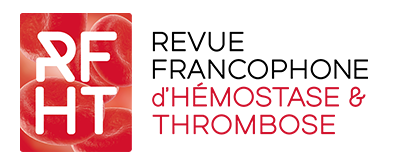RÉSUMÉ
La pratique d’une activité physique régulière peut aider à prévenir le développement de comorbidités telles que l’obésité, le syndrome métabolique et l’ostéoporose chez les patients hémophiles. Ces derniers tendent d’ailleurs à avoir une participation sportive assez similaire à celle de la population non hémophile. Afin de minimiser les risques associés à la pratique des sports et de l’activité physique, les personnes atteintes d’hémophilie devraient idéalement consulter au préalable un professionnel de l’appareil locomoteur et de l’hémostase afin de discuter d’un schéma thérapeutique personnalisé qui tiendra compte du timing de l’activité physique et de l’heure de l’injection afin de minimiser les risques hémorragiques. Lorsque le patient bénéficie de thérapies non substitutives (emicizumab, thérapie génique…), la protection hémostatique conférée par ces thérapies doit être mise en balance avec le risque lié à l’activité physique. En comparaison avec la population générale, le risque d’avoir un épisode hémorragique lors d’une activité sportive dans la population hémophile double avec un taux d’activité FVIII/FIX inférieur à 10 %. Il est donc possible de pratiquer une activité sportive de manière sécurisée chez les patients hémophiles avec un taux d’activité résiduel supérieur à 10 %. Ce seuil de 10 % est d’autant plus parlant quand on sait que les traitements non substitutifs induisent une activité hémostatique équivalente en termes d’activité facteur VIII à un niveau d’au moins 10 %. Nous illustrons cette discussion avec le cas d’un patient hémophile A sévère chez qui une optimisation de la prophylaxie antihémorragique par emicizumab a eu un impact majeur sur l’activité physique.
MOTS CLÉS
activité physique, hémophilie, prophylaxie, sports
ABSTRACT
Regular physical activity can help to prevent the development of co-morbidities such as obesity, metabolic syndrome and osteoporosis in patients with hemophilia. These patients tend to have a similar level of participation in sports as the non-hemophilia population. In order to minimize the risks associated with sports and physical activity, people with hemophilia should ideally be seen by musculoskeletal and hemostasis professionals beforehand to discuss an individualized treatment regimen that will take into account the timing of the physical activity and the time of injection in order to minimize bleeding risks. When the patient benefits from nonreplacement therapies (emicizumab, gene therapy...), the hemostatic protection conferred by these therapies must be weighed against the risk associated with physical activity. Compared to the general population, the risk of having a bleeding episode during a sport activity in the hemophilia population doubles with a FVIII/FIX activity level of less than 10%. In patients with hemophilia, it is therefore possible to practice sports safely with a residual activity level of more than 10%. This 10% cut-off is all the more significant when one considers that non-replacement therapies would have an equivalent hemostatic activity in terms of factor VIII activity of at least 10%. We illustrate this discussion with the case of a patient with severe hemophilia A in whom optimisation of anti-hemorrhage prophylaxis with emicizumab had a major impact on physical activity.
KEYWORDS
hemophilia, physical activity, prophylaxis, sports

